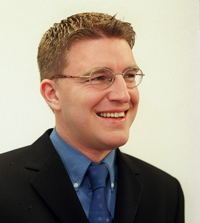
Keynote
by Barry Smyth
There is no doubting the impact that the information revolution has had on our everyday lives. How we learn, work, and play has been forever transformed by the always-on connectivity of the Internet. But this information revolution has largely been confined to the online world and, for many of us, we continue to interact with two very separate worlds: the physical world in which we live and the online world of the web. There has been a physical-digital divide. Every second of every day information is created through naturally occurring events in the physical world but these events go largely unnoticed and the information is lost. In the world of the Sensor Web this is set to change.
The catalyst for this change will come in the form of a new generation of cheap, reliable, and flexible sensor technologies, which will serve as new peripherals for the internet by bringing a whole new world of input data to the wider web. Accordingly, data will no longer just be generated from the keyboards and scanners of desktop PCs. Instead, these new sensor technologies will permit the sensing of diverse events in the physical world, from the traffic congestion in our streets to the pollution in our river systems, and from energy consumption in our cities to recycling in the home. Sensors that can be integrated with garments, and worn on the body, will permit the capture of physiological data as we exercise or recuperate. In short, this unique combination of sensors, software, and the Internet will enable new types of information services across a wide range of sectors from health and the environment to education, retail, and entertainment.
This is the vision of the Sensor Web. Its guiding principle is that better information helps people to make better decisions and that by harnessing the potential of the sensor web we can help people to live healthier, safer, and more productive lives. For example, decades worth of studies about energy usage in the home have shown that by simply informing people about the impact of their energy usage in real-time is sufficient motivation for them to cut their energy consumption by up to 15%.
Of course realising this vision is not without its challenges and as a result there is currently considerable research investment in Sensor Web technologies by funding agencies and industry players alike. Researchers at the new Centre for Sensor Web Technologies (CLARITY) are addressing these challenges head-on (see www.clarity-centre.com). CLARITY is funded by Science Foundation Ireland (SFI) and involves more than 60 researchers in University College Dublin, Dublin City University, and the Tyndall National Institute (TNI). The centre will focus on the development and application of sensor web technologies in areas such as personal health, environmental monitoring, and media and the research focus will include three different sensor modalities:
1. Sensing the Body - Focusing on the use of wearable technologies to capture physiological data form the wearer with key applications areas such as exercise, sports and personal health.
2. Sensing the Mind - Recognising the preferences of individuals and groups of users by mining sensed interaction data.
3. Sensing the Place - Focusing on the use of sensors in monitoring the world in which we live, with applications in environmental monitoring.
Within these modalities, the same challenges will arise: bridging the Physical-Digital divide, specification and deployment of adaptive middleware, and taming the information overload.
Addressing these challenges and developing practical Sensor Web solutions will, in the near time demonstrate the true potential of this technology to industry, government, and consumer alike. Indeed there are reasons to be optimistic that such technologies are accessible in the near-term. For example, modern mobile phone infrastructure provides an ideal communication network for the Sensor Web and mobile phones serve as ideal sensor platforms capable of capturing information from subscribers and their locale. Comprehensive location-sensing technologies such as GPS, for example, are now built in to most modern mobile devices and this is already inspiring a new wave of novel applications in which location sensing plays a key role. But all of this is just the beginning.
Barry Smyth









